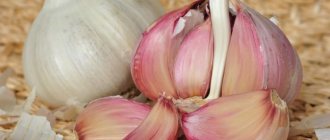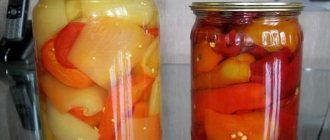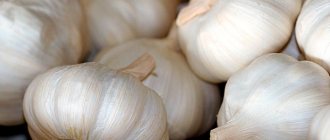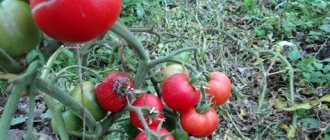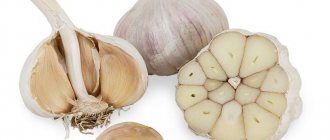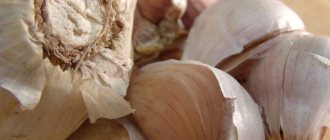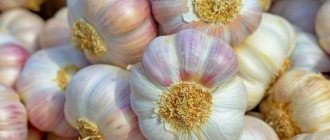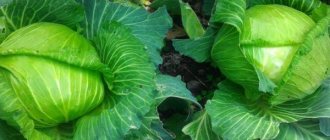Gribovsky winter garlic is a time-tested variety that is very popular among both amateur gardeners and owners of industrial farms. Thanks to its excellent taste, ease of cultivation and immunity to many diseases, the demand for Gribovsky garlic not only does not fall, but is also growing steadily.
History of selection
The Gribovsky variety of garlic includes several varieties that are similar in morphological characteristics and differ in ripening time, taste and keeping quality:
- Gribovsky Yubileiny;
- Gribovsky 60;
- Gribovsky 80.
The Gribovsky Yubileiny variety was bred by Soviet breeders from the All-Russian Research Institute for Selection and Seed Production of Vegetable Crops in the early 70s of the last century. Included in the State Register of the Russian Federation in 1976, the originator is the Federal Scientific Center for Vegetable Growing. When breeding Gribovsky garlic, scientists focused on versatility of use, frost resistance and high immunity. The variety is recommended for cultivation throughout Russia.
Comment! The variety got its name in honor of the Gribovskaya garden plant breeding station, where it was bred.
Reviews
In the era of computer technology, not only business people, but also gardeners use the Internet. Most of the comments about Gribovsky garlic left on the forums are positive. Vegetable growers confirm the immunity and tolerance to weather conditions stated in the description. The pungent taste of the vegetable is especially praised, which allows it to be used for preparing any dishes.
The main disadvantage of the variety is considered to be the small size and average keeping quality of the Gribovsky Yubileiny garlic variety.
If you have grown the Gribovsky variety, please leave feedback. Your opinion will help many gardeners weigh the pros and cons of the crop and make the right choice.
Description of garlic Gribovsky
Gribovsky garlic is a mid-season bolting winter variety. The growing season from vigorous germination to yellowing of the foliage is 80-125 days. The ground part of the plant is formed from 10-12 leaves, 2.5 cm wide and 15-20 cm long. The leaf blades are painted matte green, with a moderately pronounced waxy coating on the surface. At the height of the summer season, Gribovsky garlic throws out long arrows reaching 1-1.5 m in height. Dense green umbrellas form at the tips of the arrows, in which the bulblets subsequently ripen.
The garlic bulb of the Gribovsky variety has a rounded-flat shape with a characteristic upward slope. The denticles are covered with 4-6 dry lilac scales with darker purple veins. One garlic head contains 5-12 smooth, wide cloves of simple structure, each covered with a thin yellowish shell. The dry matter content in the pulp is about 40%. The fruits of the variety are distinguished by a rich, pungent taste and a piquant, persistent aroma.
Characteristics of the variety
Gribovsky garlic has the following varietal characteristics:
- winter hardiness and drought resistance are good;
- ripening period is average (83-122 days according to the description in the State Register);
- keeping quality is good, Gribovsky Yubileiny’s is average;
- universal purpose;
- yield – up to 1.25 kg per 1 m²;
- resistance to diseases is high;
- the variety tolerates sudden temperature changes well;
- cultivation geography - all of Russia.
Productivity
The ripening time for Gribovsky garlic depends on the climatic conditions of the region and the variety:
- Gribovsky 60 - the fastest ripening (vegetation period - 87-98 days);
- Gribovsky 80 – ripens on average about 100 days;
- Gribovsky Yubileiny is medium-late (the harvest ripens in 100-105 days or longer).
According to reviews from summer residents about winter Gribovsky garlic, the weight of an average head ranges from 22-44 g, but some gardeners managed to grow specimens reaching a weight of 100 g. With good care, more than 1.5 kg of Gribovsky garlic can be harvested from 1 m². Yields are directly affected by factors such as:
- compliance with crop rotation;
- choosing a suitable location;
- disembarkation according to the scheme;
- timely feeding and watering;
- good planting material.
Sustainability
Gribovsky garlic has good resistance to heat and frost. The variety adapts perfectly to different climatic conditions, which allows it to be grown in all regions of the Russian Federation. It tolerates sudden temperature changes and unstable weather conditions. This variety of garlic has high immunity to diseases of both bacterial and fungal origin.
Advantages and disadvantages
Each variety has its own positive and negative qualities. The advantages include:
- frost resistance;
- drought resistance;
- versatility of use;
- immunity to diseases;
- good adaptation to weather conditions;
- high or medium keeping quality;
- pronounced pungent taste.
The disadvantage of Gribovsky garlic is its tendency to shoot arrows, however, this is a characteristic feature of many winter varieties.
Basics of agricultural technology
At the end of the last century, today’s gardeners mastered the technology of growing winter garlic using “Gribovo” varieties. Nothing has changed since then. Except that the choice of fertilizers has become richer.
Landing
Winter varieties of garlic are planted in the fall. They take large, healthy cloves, which in a year will turn into full-fledged heads.
Planting no later than a month before persistent cold weather, so that the garlic plants have time to take root. But you can’t rush: lowering the tines into the warm ground too early is dangerous. They will germinate and die after frost.
In regions with the harshest climate, mid-September is appropriate. Residents of the Middle Zone plant winter crops in October. For southerners, planting stretches even until the beginning of December if the autumn is too warm.
Planting material is not difficult to find, because the popularity of the variety does not fall. Fans of traditional “Gribovsky” support and renew the culture. To do this, after 2-4 years, before winter, not the teeth, but the bulbs are planted. Caring for them is the same, and the result is one-toothed set. This is an indivisible small head, which, when planted, produces a renewed, infection-free vegetable.
The rules for preparing a place for winter garlic and step-by-step planting instructions can be found here.
Care during the growing season
The burning vegetable is an unpretentious crop. But without care, the gardener will reap a harvest of poor quality and will hasten the time of degeneration.
For garlic heads to become the pride of a summer resident, the plant needs:
- early nitrogen fertilizing - the first days after snow melt;
- Watering before the middle of the season is regular, after - depending on the weather;
- weed control, mulching;
- breaking out arrows.
This is the basic – minimal – complex. Read more about crop care in this article.
Harvest
The timing is determined by the characteristics of the variety. But they are actually affected by the weather during the growing season. A long spring and cold, rainy summer reduce the quality of the harvest and delay the harvest. In order not to guess when it’s time to take out the garlic heads, watch the plant. Experienced gardeners are guided by two criteria:
- The lower feathers have turned yellow.
- The skin on the arrow is cracked.
The second method is more accurate: the leaves may turn yellow for another reason. Therefore, 1-2 arrows are left on the beds so that the maturity indicator is visible.
10 tips on agricultural technology from an experienced gardener:
Planting and care
Garlic variety Gribovsky is planted in the fall about a month before the onset of frost. In central Russia and in particular in the Moscow region, this is the end of September - the first days of October. Depending on the growing region, planting times may vary. Planting too early can lead to untimely germination of cloves; late planting threatens poor rooting and freezing.
The area for planting garlic should be in a well-lit, sunny place. It is not recommended to plant the crop in lowlands, where melt water accumulates in the spring; close groundwater is also unacceptable. The variety will show its full potential on loose nutrient soils (sandy loam, loam); growing in heavy clay soil will not bring a rich harvest.
Rotted manure or compost is spread on the garlic beds at the rate of 5 kg per 1 m². The soil is carefully and deeply dug up and left to settle for 2 weeks.
For planting, choose smooth, healthy cloves of medium or large size. To prevent fungal diseases, planting material is soaked in a solution of fungicide or potassium permanganate. The cloves are placed in the furrows with the sharp tip facing up without pressing into the soil, as this can slow down root growth. Planting depth - 2-5 cm, distance between rows - 30 cm, between bulbs - 10 cm. You can put a layer of mulch (hay, straw) between the rows - this will prevent rapid evaporation of moisture and drying out of the top layer of soil, and will also inhibit the growth of weeds .
Warning! There is no need to plant garlic where onions or potatoes used to grow, since these crops are affected by the same diseases.
Legumes, cucumbers, and cabbage are considered the best predecessors of garlic.
Further care for Gribovsky garlic comes down to watering, fertilizing, loosening the soil and weeding. In dry weather without precipitation, garlic should be watered once a week. After watering, the soil is loosened and weeded.
The yield of the Gribovsky variety will increase if in the spring you feed the plantings with chicken manure and fertilizers with a high content of nitrogen and phosphorus. The first time the beds are fertilized is after the snow melts, then in early and mid-April.
In June, the shoots of garlic of the Gribovsky variety must be removed when they reach a length of 10-15 cm. If this is not done, the plant’s energy will be spent on flowering and not on bulb formation. Only a few arrows are left for sowing next year.
Comment! By the appearance of the arrows, you can determine the degree of ripening of the garlic.
3 weeks before the planned harvest date, stop watering and feeding the garlic. During this time, the heads will acquire a rich taste and aroma and will not be watery. Garlic is pulled out in dry weather, dried in a shaded, well-ventilated place, cleaned and sorted. It is optimal to store garlic in a dark, cool, dry place.
Harvest and storage
You can store garlic in different ways
When the stems and leaves of the crop begin to turn yellow and then die, you can begin to harvest Gribovsky garlic. The heads are dug out carefully, using a pitchfork, and left to lie in the sun to dry and ripen.
Important!
You can harvest garlic only in sunny weather, when the ground is not wet. If the heads are dug up after or during rain, they will not store well.
Before storing garlic, the tops are cut off, dried thoroughly for several days to weeks, and sorted. It is important to sort the heads by size and quality. The largest, smallest and damaged ones go to food first, and those that are whole, medium in size, can be put away, they last the longest. Garlic can be stored in different ways. Most often, they are folded into nets and hung in a cool, dark place where there is no dampness or drafts.
Diseases and pests
In very rare cases, if the rules of agricultural technology are not followed, the variety can be affected by diseases such as:
- fusarium;
- bacteriosis;
- cervical rot;
- white rot;
- green mold;
- downy mildew;
- rust.
To avoid possible problems associated with these diseases, you need to choose healthy planting material, remove weeds and loosen the soil in a timely manner, and do not overuse frequent watering.
Garlic variety Gribovsky can be attacked by onion moth and garlic nematode. In order to prevent these pests, it is necessary to adhere to the rules of crop rotation, burn the tops after harvesting, and carefully dig up the soil in spring and autumn.
Advice! If you find longitudinal yellow stripes on the leaves of garlic, yellowing of the leaves and drying out of the tips, you need to urgently treat the plants against onion moths with the preparation “Iskra”, “Dachnik” or “Metaphos”.
